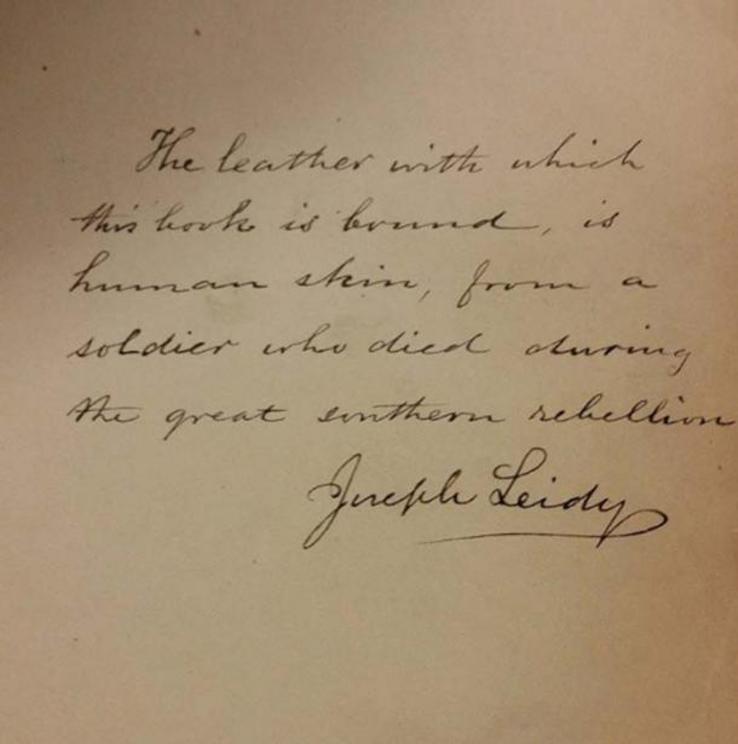Books bound in human skin – the practice isn’t as rare as you might think!
Anthropodermic bibliopegy refers to the practice of binding books in human skin . According to folk legend, the binding of books (or more appropriately manuscripts, as they were hand-written) in human skin can be traced all the way back to the Middle Ages. The first reliable accounts of books being bound in human skin, however, date to the 17 th century and it seems to have become popular during the 19 th century.
When Did the Practice of Anthropodermic Bibliopegy Begin?
The use or abuse of a dead person’s skin may be traced back to ancient times. Reliefs from the Neo- Assyrian period, for instance, show prisoners or captives being flayed. This was a slow and painful method of execution in which the skin is removed from the body, preferably in one piece. After a person was flayed, the skin would be displayed on the city walls as a means of instilling fear into the hearts of the people. Fast forward to the Middle Ages, the tanning of a person’s skin after death, as well as the preservation of body parts, became a popular practice. It is perhaps due to this practice that rumors of human skin being used to bind books during the Medieval period began to circulate.

Michelangelo's The Last Judgment - St Bartholomew holding the knife of his martyrdom and his flayed skin.(Alonso de Mendoza / Public Domain )
In reality, however, there is little evidence to prove that there were Medieval manuscripts being bound in human skin. Although there are some historical accounts stating that there was a 13 th century Bible and Decretal (a papal decree concerning a point of canon law) written on human skin, the credibility of these reports has been in question.
The First Example of Anthropodermic Bibliopegy
The first reliable accounts of books bound in human skin date to the late 16 th / early 17 th century. One such example is a 17 th Spanish law text called Practicarum quaestionum circa leges regias , which is today owned by the Harvard Law School. There is an inscription naming the deceased, as well as a claim that his flayed skin was used as the book’s binding. Analysis of the binding, however, has revealed that it is in fact sheepskin. It has been speculated that the original binding (which might as well have been human skin) was replaced at some point of time, or that the inscription was the product of someone’s macabre imagination (a form of practical joke, so to speak) and therefore holds no truth.

Written in a book bound with human skin. (Megan Rosenbloom / Flicker )
Anthropodermic Bibliopegy Becomes Common Place
It was only around the time of the French Revolution that anthropodermic bibliopegy became more common. Apparently, during the Reign of Terror , the skins of those executed by the regime were sometimes used to bind books. Examples of books bound in human skin from this period include a copy of the Rights of Man and several copies of the French Constitution of 1793.

Holbein's Alphabet of death - bound in human skin in Paris in 1856. (BeatrixBelibaste / Public Domain )
Anthropodermic bibliopegy became a particular subject of interest during the 19 th century, especially among the medical profession. This practice is much better documented during this period and we have much information about the people who used human skin to bind books, as well as those whose skins were used as bindings.

A book in the Wellcome Library bound in human skin. (Wellcome Library / CC BY-SA 4.0 )
Famous Examples of Anthropodermic Bibliopegy
As an example, one of the few surviving examples of a book bound in human skin is owned by the Bristol Record Office. The skin that was used belonged to an 18-year-old man by the name John Horwood, who was sentenced to hang for the murder of Eliza Balsum. Horwood was the first person to be hanged at Bristol Gaol, and after his execution, his corpse was dissected during a public lecture at the Bristol Royal infirmary by a surgeon named Richard Smith. The surgeon then decided to use part of Horwood’s skin to bind a collection of papers about the case. Another example is Joseph Leidy, an American professor of anatomy. One of his books, An Elementary Treatise on Human Anatomy , is bound with the skin of “a soldier who died during the great Southern Rebellion”.
Testing Can Now Be Used to Confirm Anthropodermic Bibliopegy
Today, human skin and animal skin can be differentiated through scientific analysis and this is a task that has been performed by the Anthropodermic Book Project. As of October 2018, a total of 49 alleged anthropodermic books have been identified. Of these, the bindings of 30 books have been tested, 18 of which were confirmed to be human skins, while the other 12 were not of human origin.

Example of Anthropodermic bibliopegy – an 18-19 th century notebook allegedly covered with human skin. Source: CC BY-SA 4.0
For full references please use source link below.
Video can be accessed at source link below.
